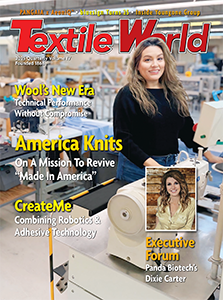PFÄFFIKON, Switzerland — July 5, 2018 — Stäubli will be among the exhibitors when the Exintex trade fair opens its doors in Puebla, Mexico this October. This major business platform for the Latin American textile industry is taking place within a challenging economic environment. For weaving and knitting mills to remain competitive, they must find ways to boost productivity and efficiency. Visitors to the Stäubli booth at no. 110-111 will have an excellent opportunity to find out how Stäubli’s solutions for workflow automation, automated weaving preparation, shedding for frame and Jacquard weaving, and sock knitting can help them optimize their mill operations and reinforce their market position.
SAFIR S40 – automatic drawing in for denim and gray material warps
With the SAFIR S40 automatic drawing-in installation, Stäubli offers further time savings in the weaving preparation process for cotton fabrics. Featuring AWC (ActiveWarpControl) technology, this machine assures one-stroke drawing in into drop wires, healds, and reed, resulting in perfectly aligned yarns with no crossed or double ends. The end product of this efficient warp preparation is a perfectly prepared weaving harness that leads to first-quality fabrics and higher weaving machine output. This installation allows optimized workflow planning, including just-in-time preparation if needed. Different installation layout possibilities are possible, in accordance with the available space and the mill’s transport equipment. This flexible machine can easily be integrated into any weaving mill.
High-speed frame weaving solutions for standard woven applications
The broad range of Stäubli cam motions and dobbies includes ideal machines for any type of weft insertion system for any application. The latest generation of the S3000 and S3200 series of rotary dobbies incorporates a new locking system, which is the heart of every dobby. This evolutionary feature provides enhanced security for heald frame selection, allowing higher running speeds, superior reliability, and less noise and vibration. And Stäubli has increased the efficiency of frame weaving installations even further with its recently launched maintenance-free harness motions.
Extremely reliable Jacquard machines for high-quality fabrics
When it comes to Jacquard weaving, mills can choose from Stäubli’s wide and competitive range of Jacquard machines. The renowned SX model is very robust, wear-resistant, and designed for many years of daily use with a minimum of maintenance. Available in two formats (1,408 or 2,688 hooks) the machine supports excellent results in the form of e.g. terry cloth, apparel fabrics, or seat cover fabrics.
For large-format patterned fabrics with heavy weaving loads, Stäubli offers the LX series, including the LXL Jacquard machine, designed for extra-heavy load capacity. This model can be equipped with 6,144 to 16,384 hooks. Formats up to 32,768 can be achieved by combining two machines. And because a precisely matched Jacquard system gives mills even higher performance, Stäubli offers high-end harnesses for any application, which also enables weavers to swiftly respond to changing market needs.
From terry cloth to technical textiles, Stäubli Jacquard machines master every challenge and allow the mill to profit from quality results while reducing production time thanks to very high running speeds.
Automatic toe-linking device for a shorter sock production process
Stäubli’s recently launched D4S device is an automation solution that significantly shortens the production process for socks. Socks must no longer be removed from the knitting machine for closing the toe on a separate machine. The D4S can be mounted directly on the circular sock knitting machine; it closes the sock immediately after knitting. The D4S significantly increases output and ensures optimum quality. It is also available for new circular knitting machines.
Original spare parts for longevity and close customer service
Stäubli wants its customers to get the most out of their machines, benefitting from long and dependable operation and maximum service life. That’s why Stäubli specialists help mills select the right equipment for their needs, support the mill during installation and startup, ensure local after-sales service, and assure availability of original spare parts even many years after the purchase.
The pioneering products of Stäubli are the result of a well-balanced combination of reliable performance, technical perfection, and proven technologies and relied on by weavers around the world to produce high-quality fabrics for demanding markets such as the automotive sector.
Posted July 13, 2018
Source: Stäubli Group




